Comprehensive Characterization and Impact Analysis of Interlayers on CO2 Flooding in Low-Permeability Sandstone Reservoirs
Abstract
1. Introduction
2. Materials and Methods
2.1. Samples
2.2. Rock Characterization
2.2.1. Petrophysical Interlayers
2.2.2. Argillaceous Interlayers
2.2.3. Interlayers Petrophysical Property
2.3. Well-Logging Response
2.4. 3D Distribution
2.5. Dynamic Model Establishment
3. Results and Discussion
3.1. Petrophysical Interlayer Sealing Capacity
3.1.1. Petrophysical Barriers
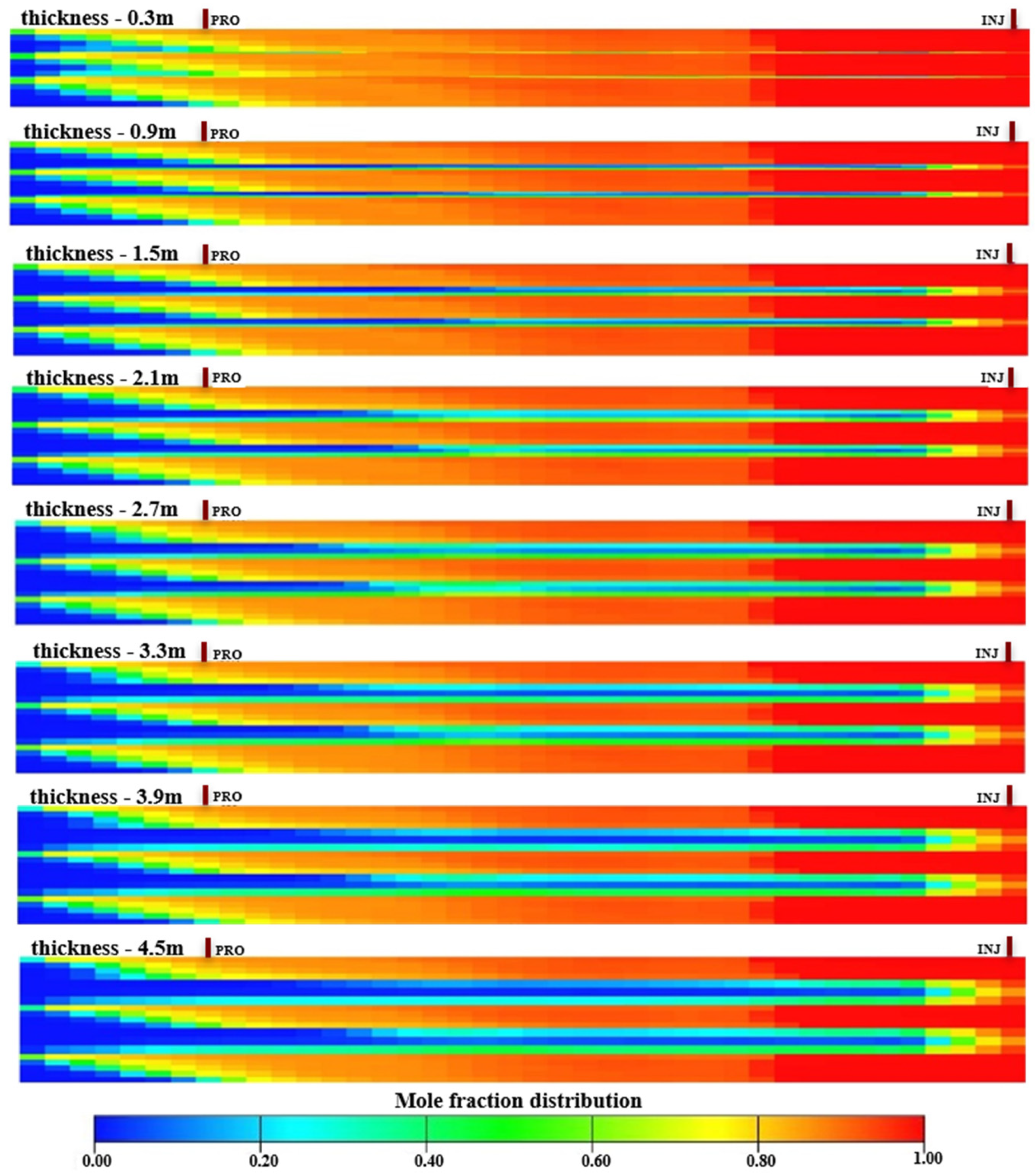
3.1.2. Petrophysical Interbeds
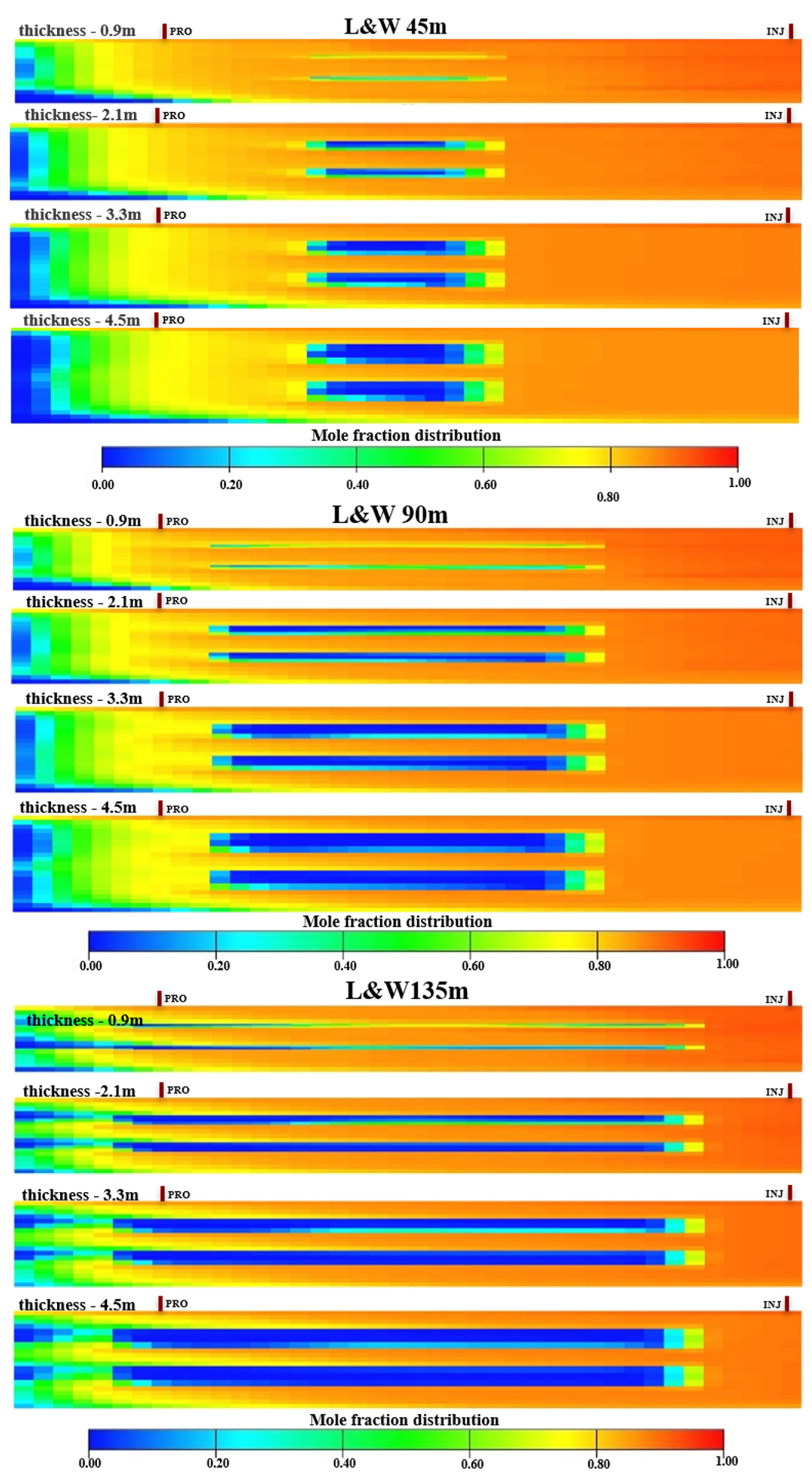
3.2. Argillaceous Interlayer Sealing Capacity
3.2.1. Argillaceous Barriers
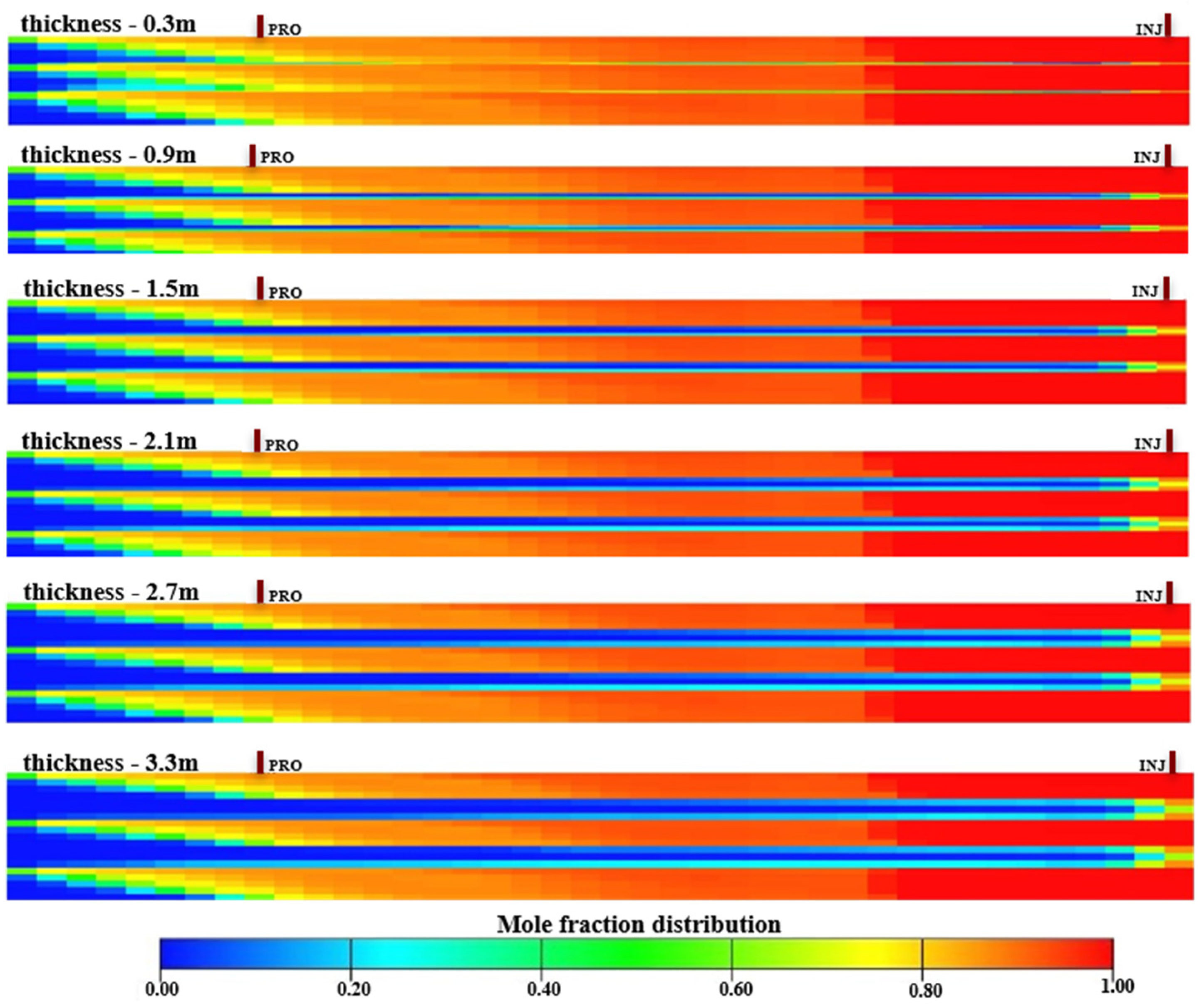
3.2.2. Argillaceous Interbeds
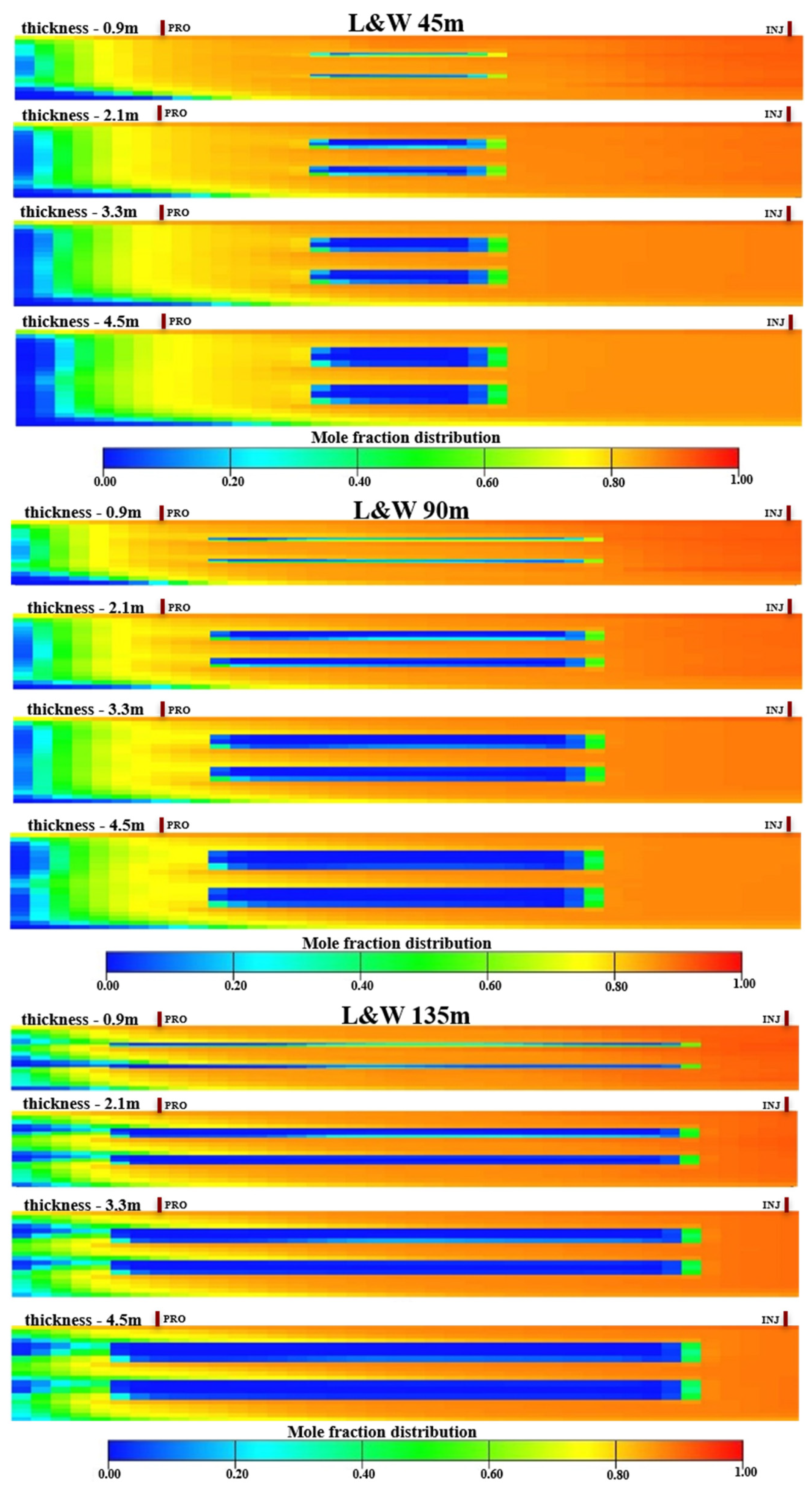
3.3. Impact of Interlayers on CO2 Flooding
3.3.1. Impact of Barriers on CO2 Flooding
3.3.2. Impact of Interbeds on CO2 Flooding
4. Conclusions
Author Contributions
Funding
Data Availability Statement
Acknowledgments
Conflicts of Interest
References
- Liu, Y.; Yi, Y.-S.; Qi, L. A Study on Interlayers in Thick Oil Reservoir in Anpeng Mainbody Area of Zhao-Oilfield. China’s Manganese Ind. 2016, 5, 19–22. [Google Scholar]
- Pruess, K. Leakage of CO2 from geologic storage: Role of secondary accumulation at shallow depth. Int. J. Greenh. Gas Control 2008, 2, 37–46. [Google Scholar] [CrossRef]
- Rinaldi, A.-P.; Rutqvist, J.; Cappa, F. Geomechanical effects on CO2 leakage through fault zones during large-scale underground injection. Int. J. Greenh. Gas Control 2014, 20, 117–131. [Google Scholar] [CrossRef]
- Xu, L.; Myers, M.; Li, Q.; White, C.; Zhang, X.-Y. Migration and storage characteristics of supercritical CO2 in anisotropic sandstones with clay interlayers based on X-CT experiments. J. Hydrol. 2020, 580, 124239. [Google Scholar] [CrossRef]
- Xu, L.; Li, Q.; Myers, M.; White, C.; Tan, Y.-S. Experimental and numerical investigation of supercritical CO2 migration in sandstone with multiple clay interlayers. Int. J. Greenh. Gas Control 2021, 104, 103194. [Google Scholar] [CrossRef]
- Fu, L.; Ren, Z.; Si, W.; Ma, Q.; Huang, W.; Liao, K.; Huang, Z.; Wang, Y.; Xu, P. Research progress on CO2 capture and utilization technology. J. CO2 Util. 2022, 66, 102260. [Google Scholar] [CrossRef]
- Alcalde, J.; Flude, S.; Wilkinson, M.; Johnson, G.K.; Edlmann, K.; Bond, C.E.; Scott, V.; Gilfillan, S.M.V.; Ogaya, X.; Haszeldine, R.S. Estimating geological CO2 storage security to deliver on climate mitigation. Nat. Commun. 2018, 9, 2201. [Google Scholar] [CrossRef]
- Zhang, X.; Wei, B.; Shang, J.; Gao, K.; Pu, W.; Xu, X.; Wu, C.; Sun, L. Alterations of geochemical properties of a tight sandstone reservoir caused by supercritical CO2-brine-rock interactions in CO2-EOR and geosequestration. J. CO2 Util. 2018, 28, 408–418. [Google Scholar] [CrossRef]
- Ji, M.; Kwon, S.; Choi, S.; Kim, M.; Choi, B.; Min, B. Numerical investigation of CO2-carbonated water-alternating-gas on enhanced oil recovery and geological carbon storage. J. CO2 Util. 2023, 74, 102544. [Google Scholar] [CrossRef]
- Zhang, J.; Zhang, L.H.; Hu, S.Y.; Nan, L. The Genesis and Characteristics and Identification of Intercalations in Non-marine Reservoir with Clastic Rock. Well Logging Technol. 2003, 27, 221–224. [Google Scholar] [CrossRef]
- Zhang, W.; Xie, Z.J. Research on reservoir bed heterogeneity, interlayers and seal layers and controlling factors of 2+3 sands of upper second member, Shahejie Formation, in the west of the Pucheng Oilfield. Pet. Sci. 2008, 5, 135–144. [Google Scholar] [CrossRef]
- Sun, T.J.; Mu, L.X.; Zhao, G.L. Classification and characterization of barrier-intercalation in sandy braided river reservoirs: Taking Hegli Oilfield of Muglad Basin in Sudan as an example. Pet. Explor. Dev. 2014, 41, 125–134. [Google Scholar] [CrossRef]
- Han, R.B.; Liu, Q.; Jiang, T.W.; Xu, B.M.; Xu, C.H.; Zhao, L.; Lei, C.; Zhang, P.-C. Feature origin and distribution of calcareous interlayers: A case of Carboniferous Donghe sandstone in Hade Oil Field Tarim Basin NW China. Pet. Explor. Dev. 2014, 41, 475–484. [Google Scholar] [CrossRef]
- Wang, Y.; Liu, J.; Wang, J.G.; Shi, K.-B.; Liu, B. Major controlling factors for the formation of inter-layer of Donghe sandstone of Donghe1 reservoir in Tarim Basin and its fluid source. Acta Pet. Sin. 2015, 36, 174. [Google Scholar] [CrossRef]
- Wang, Z.-Y.; Pan, M.; Shi, Y.-M.; Dong, Y. Interlayer identification and spatial distribution in onshore sandstone Donghe 1 reservoir Tarim Basin. Acta Pet. Sin. 2015, 36, 966. [Google Scholar] [CrossRef]
- Wang, X.Y.; Jiang, Z.X.; Yue, D.L.; Wang, X.; Wang, X.B. Patterns of barrier-interlayers in mouth bar of fluvial dominated delta reservoirs. J. Southwest Pet. Univ. 2017, 39, 9–17. [Google Scholar]
- Guo, J.; Wang, W.; Tan, J.; Peng, Q.; Zhang, D. Fine characterization method for interlayers in complex meander river sandstone reservoir: A case study of Um7 sand of C oilfield in bohai bay area. Int. J. Geosci. 2019, 10, 14. [Google Scholar] [CrossRef]
- Yu, H.M.; Song, Y.C.; Peng, Y.T.; Liu, B.; Li, T.; Shi, K.B. Characteristics, Genesis and Distribution of Interlayers in E31 Reservoir of Gasikule Oilfield, Qaidam Basin. Spec. Oil Gas Reserv. 2021, 28, 79–87. [Google Scholar] [CrossRef]
- Cheng, C.; Yu, W.; Bai, X. The research on method of interlayer modeling based on seismic inversion and petrophysical facies. Petroleum 2016, 2, 20–25. [Google Scholar] [CrossRef]
- Li, Y.; Yang, Y. Pore Scale Dynamic 3D Imaging of Water-Alternating-Gas Flooding and CO2-foam Flooding in a Double Layer Core, Computational and Experimental Simulations in Engineering. Proc. ICCES 2023, 143, 775–782. [Google Scholar] [CrossRef]
- Li, T.; Long, A.L.; Liu, B.; Ding, X.; Yu, H.; Lu, S.; Song, Y.; Shi, K.B. Breakthrough pressure and development strategy for gas injection in interlayers in low-permeability sandstone reservoirs: A case study of the Gasikule E31 reservoir Qaidam Basin. Acta Pet. Sin. 2021, 42, 1364. [Google Scholar] [CrossRef]
- Chai, X.; Tian, L.; Dong, P.; Wang, C.; Peng, L.; Wang, H. Study on recovery factor and interlayer interference mechanism of multilayer co-production in tight gas reservoir with high heterogeneity and multi-pressure systems. J. Pet. Sci. Eng. 2022, 210, 109699. [Google Scholar] [CrossRef]
- Wei, S.; Duan, Y.; Wei, M.; Ren, K.; Lu, C.; Zhan, J.; Tang, Y. Experimental study on the effect of different distributed interlayer on SAGD performance. J. Pet. Sci. Eng. 2022, 209, 109827. [Google Scholar] [CrossRef]
- Yang, Y.; Li, X.; Yang, X.; Li, X. Influence of reservoirs/interlayers thickness on hydraulic fracture propagation laws in low-permeability layered rocks. J. Pet. Sci. Eng. 2022, 219, 111081. [Google Scholar] [CrossRef]
- Zhang, L.; Li, C.; Zhang, Y.; Wang, X.; Yao, X.; Sun, Y.; Li, F.; Yang, H. CO2-EOR and storage in a low-permeability oil reservoir: Optimization of CO2 balanced displacement from lab experiment to numerical simulation. Geoenergy Sci. Eng. 2024, 243, 213325. [Google Scholar] [CrossRef]
- Zhang, Y.Q.; Yang, S.l.; Bi, L.F.; Gao, X.Y.; Shen, B.; Hu, J.T.; Luo, Y.; Zhao, Y.; Chen, H.; Li, J. A technical review of CO2 flooding sweep-characteristics research advance and sweep-extend technology. Pet. Sci. 2024; in press. [Google Scholar] [CrossRef]
- Du, S.; Bai, L. Future potential research hotspots on the precise integration of geology and engineering in low-permeability oil reservoirs. Adv. Geo-Energy Res. 2024, 14, 4–7. [Google Scholar] [CrossRef]
- Zhao, X.; Chen, Z.; Zhang, L.; Liao, X.; Awotunde, A.A. Leakage risk assessment on sealing efficiency of caprock during CO2 huff-n-puff for safe sequestration. Geoenergy Sci. Eng. 2024, 240, 213056. [Google Scholar] [CrossRef]
- Abitkazy, T.; Du, S.; Xu, F.; Shi, Y. Pore structure characterization of clay minerals in the Lower Karamay formation conglomerate reservoir in the Junggar basin and its impact on hydrocarbon storage and seepage. Acta Geol. Sin.-Engl. Ed. 2021, 95, 558–569. [Google Scholar] [CrossRef]
- Du, S.; Xu, F.; Abitkazy, T.; Zhou, B.; Kou, G.; Shi, Y. Anisotropy characteristics of element composition in Upper Triassic “Chang 8” shale in Jiyuan district of Ordos Basin, China: Microscopic evidence for the existence of predominant fracture zone. Fuel 2019, 253, 685–690. [Google Scholar] [CrossRef]
- Li, Q.; Ning, Z.; Wu, S.; Wang, B.; Li, Q.; Li, H. A Multiphase and Multicomponent Model and Numerical Simulation Technology for CO2 Flooding and Storage. Energies 2024, 17, 3222. [Google Scholar] [CrossRef]
- Fan, K.; Zhu, W.Q.; Zhou, D.Y.; Gao, S.S.; Zhao, G.Q.; Hu, Z.M. Effect of interlayers in thick sandstone reservoir for gas injection: A case study of Donghe 1 Carboniferous oil reservoir in Tarim Basin. Acta Pet. Sin. 2015, 36, 475–481. [Google Scholar] [CrossRef]
- Wei, N.; Gill, M.; Crandall, D.; Mcintyre, D.; Wang, Y.; Bruner, K.; Li, X.C.; Bromhal, G. CO2 flooding properties of Liujiagou sandstone: Influence of sub-core scale structure heterogeneity. Greenh. Gases Sci. Technol. 2014, 4, 400–418. [Google Scholar] [CrossRef]
- Ma, X.; Yang, G.-C.; Yu, Y.; Li, X.-F.; Liu, X.-T. Effect of clay mineral contents on sealing capacity of caprock of CO2 geological storage. Bull. Miner. Pet. Geochem 2019, 38, 121–129. [Google Scholar] [CrossRef]
- Tan, J.; Chen, J.; Zhang, Z.; Liu, C.; Zhang, W. Identification of Interlayer in strong bottom water reservoir and its influence on development effect. J. Geosci. Environ. Prot. 2022, 10, 132–138. [Google Scholar] [CrossRef]
- Espinoza, D.N.; Santamarina, J.C. CO2 breakthrough—Caprock sealing efficiency and integrity for carbon geological storage. Int. J. Greenh. Gas Control 2017, 66, 218–229. [Google Scholar] [CrossRef]
- Cui, G.; Zhan, L.; Tan, C.; Ren, S.; Zhuang, Y.; Enechukwu, C. Injection of supercritical CO2 for geothermal exploitation from sandstone and carbonate reservoirs: CO2–water–rock interactions and their effects. J. CO2 Util. 2017, 20, 113–128. [Google Scholar] [CrossRef]
- Abitkazy, T.; He, Y.; Chen, F.; Yuan, D.; Li, X.; Bai, Y.; Omarbekov, B.; Sarbayev, A. Research on the influence of mineral heterogeneity under different CO2 injection schemes in low permeability reservoirs. Nat. Gas Ind. B 2024, 11, 291–302. [Google Scholar] [CrossRef]
- Cheng, Q.; Tang, J.; Liu, Y.; Lu, Y.; Jia, Y.; Zhang, H.; Gong, T.; Zhao, G. Capillary sealing capability alteration of shale caprock induced by CO2-brine-rock interaction: Implication for CO2 geological storage. Geoenergy Sci. Eng. 2024, 41, 213149. [Google Scholar] [CrossRef]
- Zhang, Q.; Xu, Q.; Yang, Y.; Iglauer, S.; Liu, J.; Liu, F.; Yao, J. Permeability heterogeneity effects on density-driven CO2 natural convection and carbon sequestration efficiency. Fuel 2024, 363, 130871. [Google Scholar] [CrossRef]
- Chen, B.; Li, Q.; Tan, Y.; Zhang, Y.; Yu, T.; Ma, J.; Zhong, Y.; Li, X. Caprock sealing integrity and key indicators of CO2 geological storage considering the effect of hydraulic-mechanical coupling: X field in the Bohai Bay Basin, China. Eng. Geol. 2024, 342, 107741. [Google Scholar] [CrossRef]
- Al-Bayati, D.; Saeedi, A.; Myers, M.; White, C.; Quan, X. Insights into immiscible supercritical CO2 EOR: An XCT scanner assisted flow behaviour in layered sandstone porous media. J. CO2 Util. 2019, 32, 187–195. [Google Scholar] [CrossRef]
- Gao, X.; Yang, S.; Shen, B.; Tian, L.; Li, S.; Zhang, X.; Wang, J. Influence of Reservoir Spatial Heterogeneity on a Multicoupling Process of CO2 Geological Storage. Energy Fuels 2023, 37, 14991–15005. [Google Scholar] [CrossRef]
- Kim, K.; Makhnenko, R.Y. Short-and long-term responses of reservoir rock induced by CO2 injection. Rock Mech. Rock Eng. 2022, 55, 6605–6625. [Google Scholar] [CrossRef]
- United Nations Framework Convention on Climate Change the Paris Agreement. Available online: https://unfccc.int/process-and-meetings/the-paris-agreement (accessed on 27 April 2021).
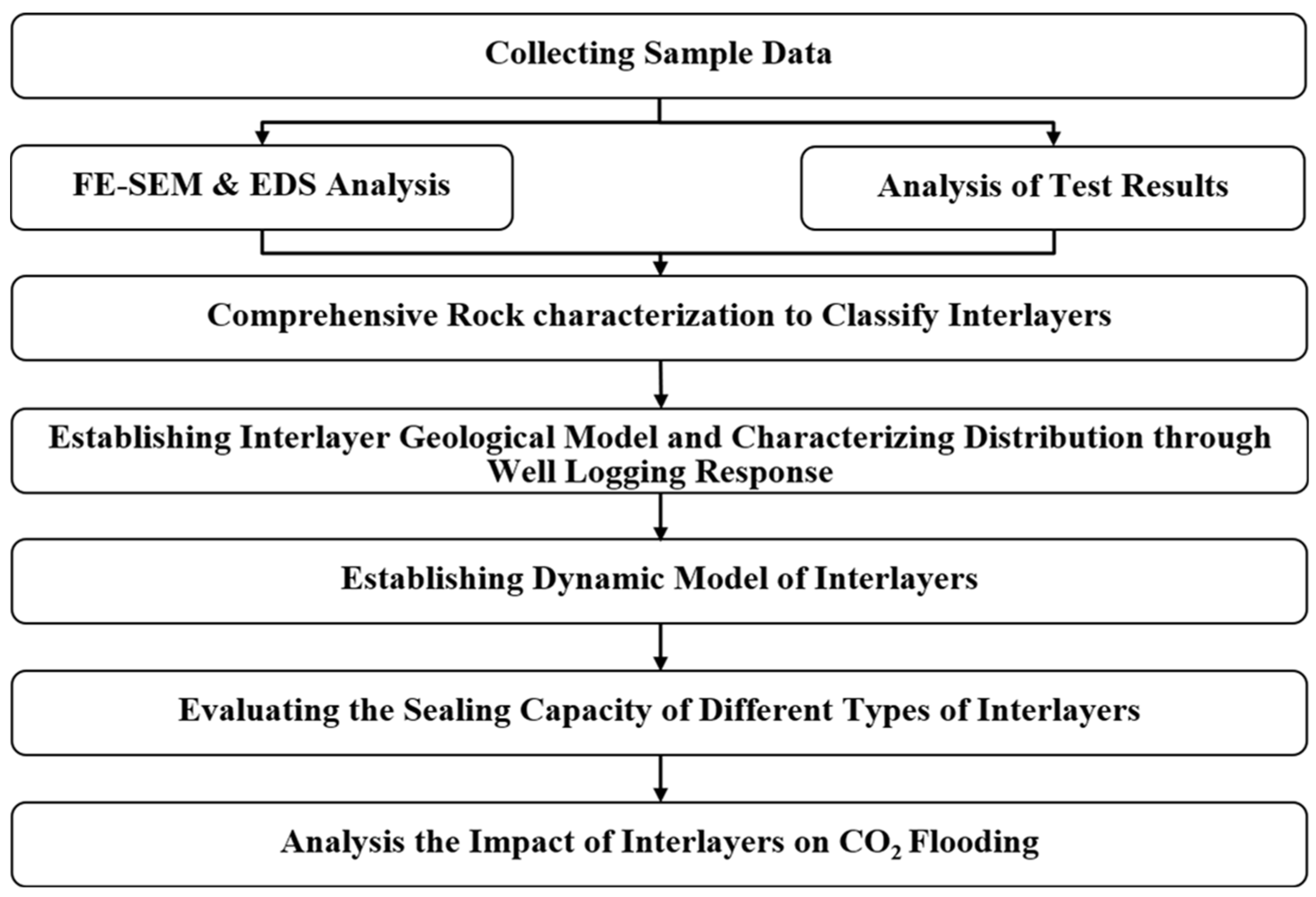
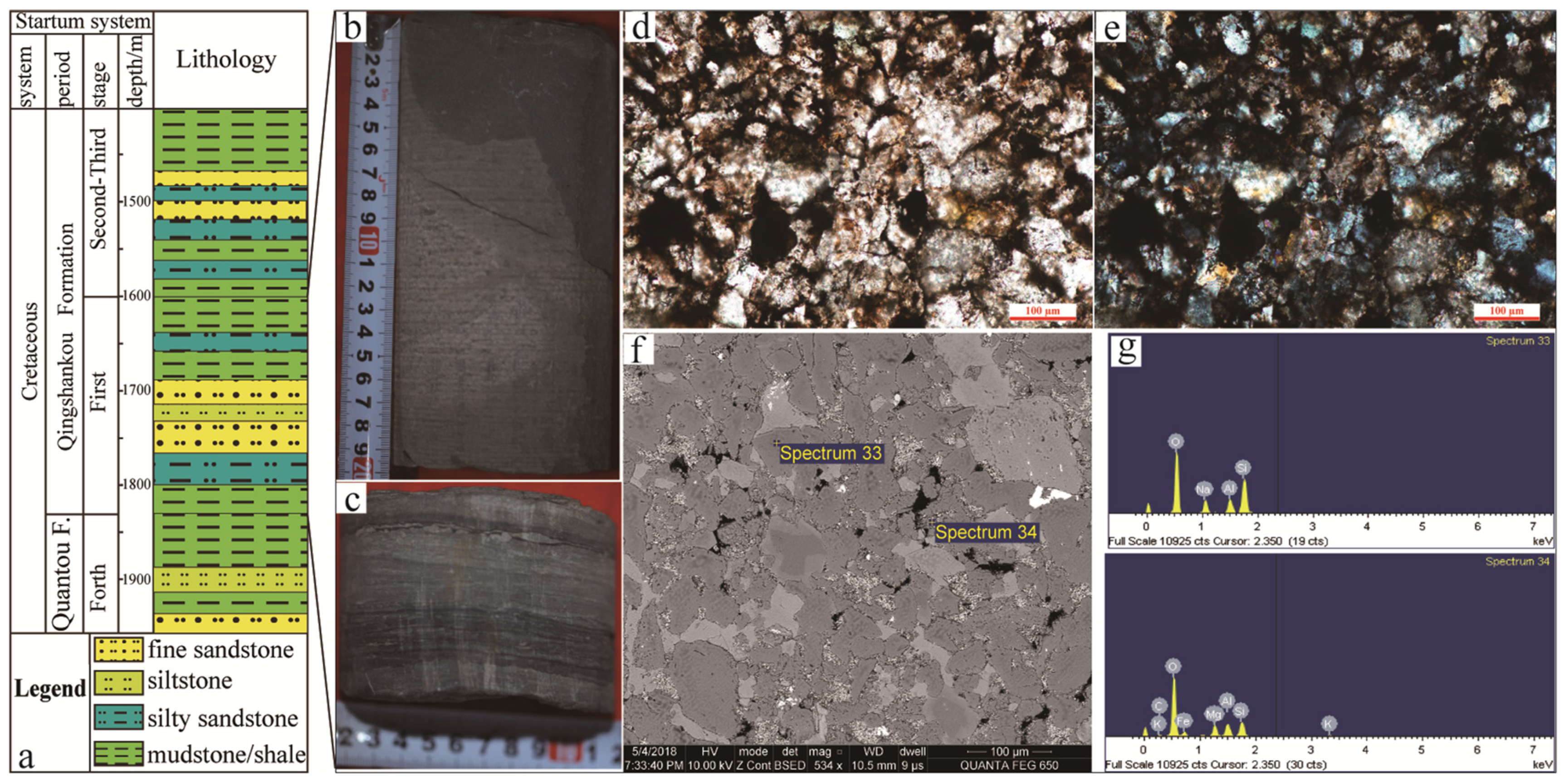
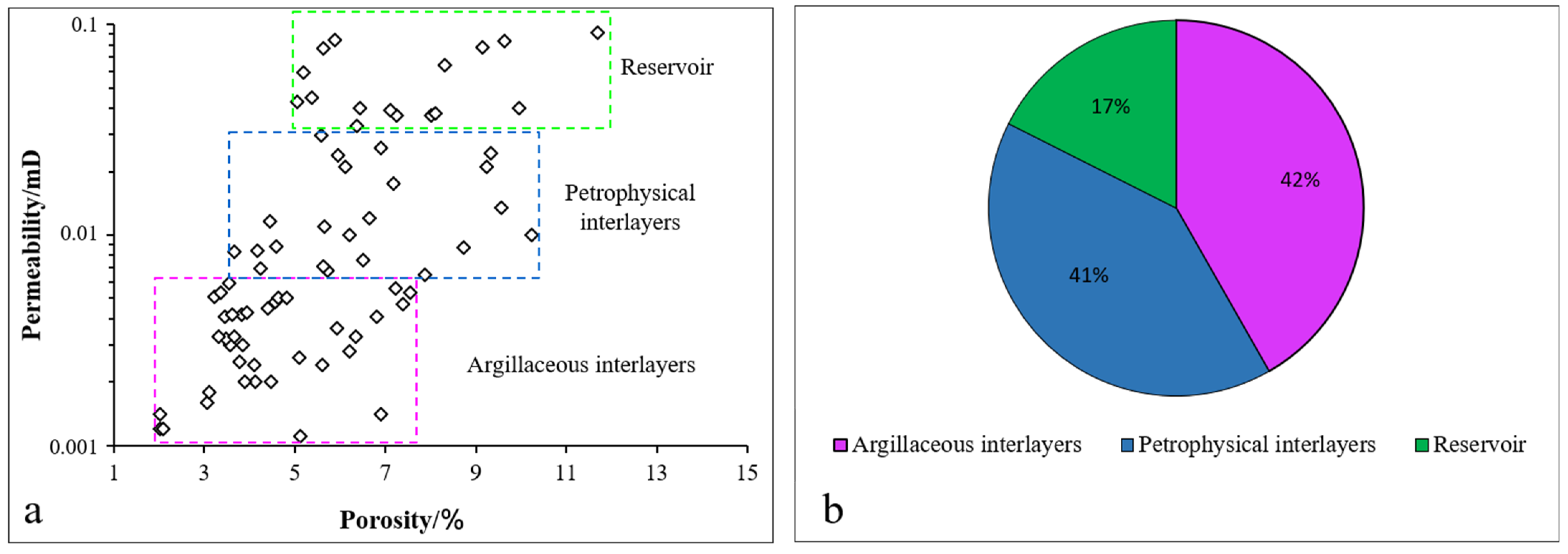
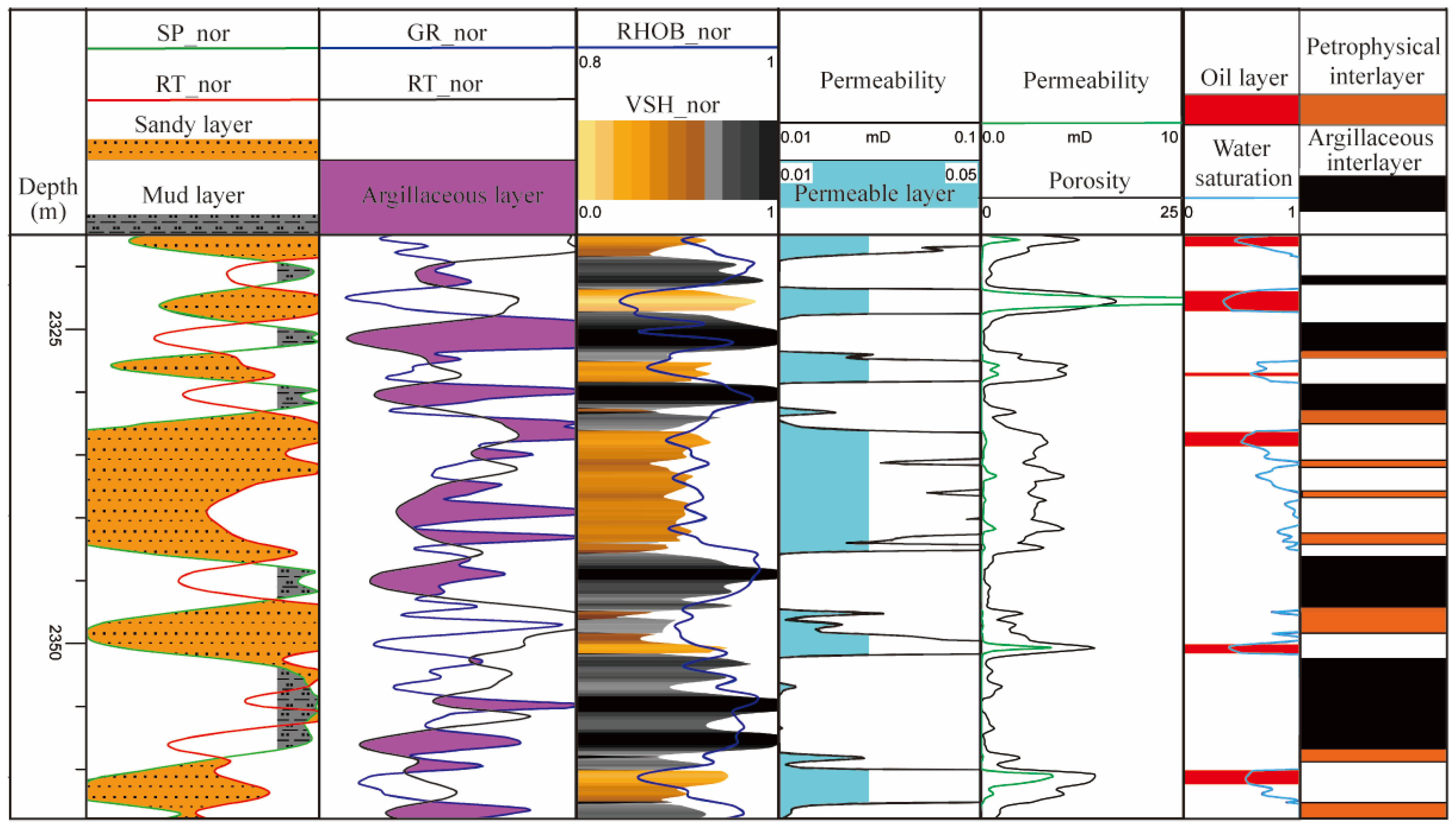
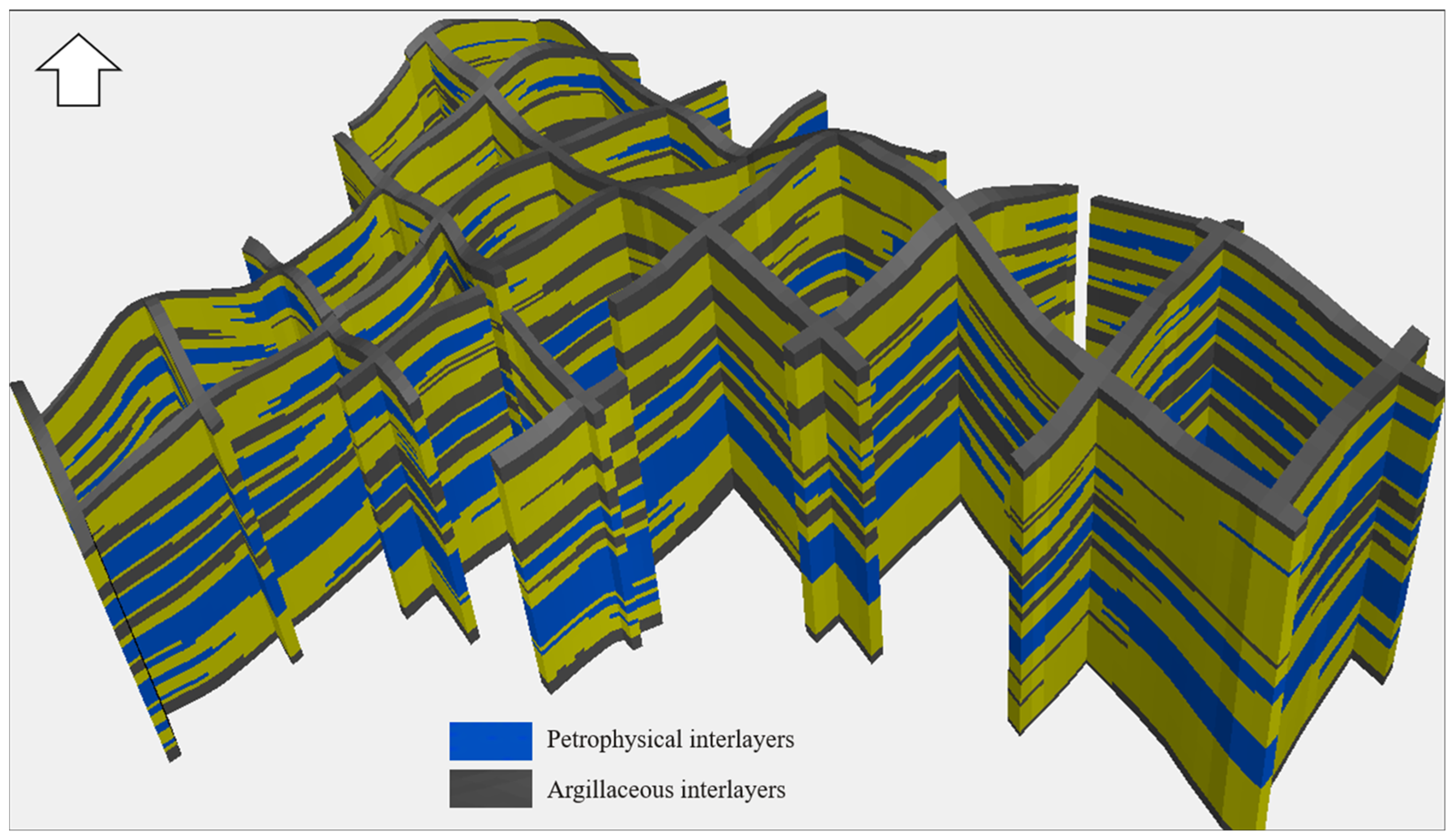

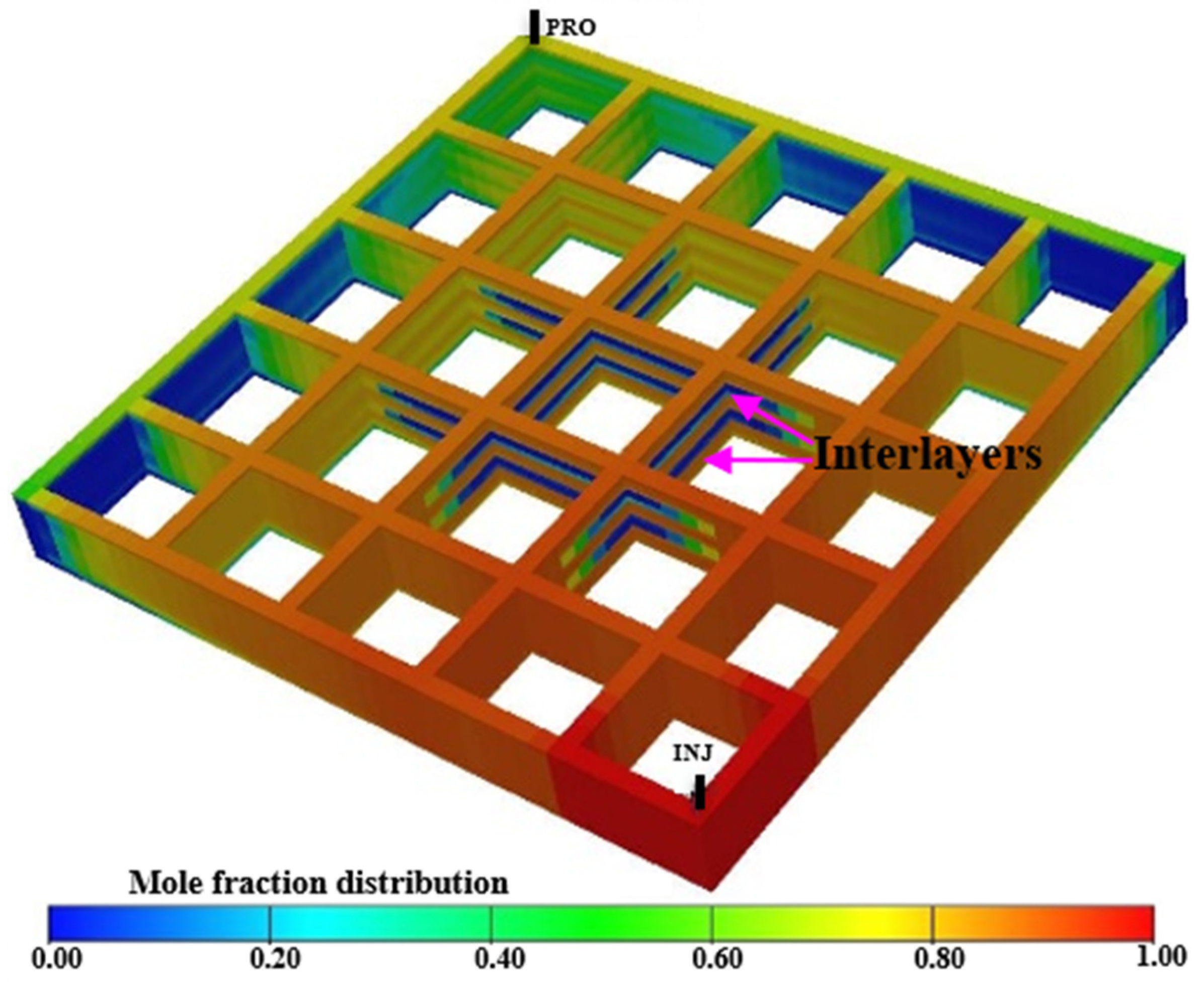



| Interlayer Type | Inclination (°) | Maximum Thickness (m) | Minimum Thickness (m) | Mean Thickness (m) | Maximum Length (m) | Minimum Length (m) |
|---|---|---|---|---|---|---|
| petrophysical interlayers | 0–10 170–180 | 17.10 | 0.25 | 4.30 | - | - |
| petrophysical interbeds | 0–10 170–180 | 3.33 | 0.41 | 1.05 | 981 | 6.40 |
| argillaceous barriers | 0–5 170–180 | 18 | 0.33 | 5.90 | - | - |
| argillaceous barriers | 0–5 170–180 | 2.44 | 0.27 | 1.22 | 1813 | 24 |
| Category | Parameter | Value |
|---|---|---|
| Model Configuration | Simulation duration | 10 years |
| Number of wells | 1 injection well, 1 production well | |
| Well spacing | 180 m | |
| Grid dimensions | 40 × 40 × 19 cells | |
| Grid size | X, Y: 4.5 m; Z: 1 m | |
| Formation conditions | Pressure 17 MPa; Temperature 90 °C | |
| Interlayer representation | Grid cells 5–7 and 12–14 | |
| Oil layer representation | Grid cells 1–4 and 15–19 | |
| Petrophysical Parameters | Argillaceous interlayer porosity | 5% |
| Argillaceous interlayer permeability | 0.005 mD | |
| Petrophysical interlayer porosity | 7% | |
| Petrophysical interlayer permeability | 0.02 mD |
| Property | Value |
|---|---|
| Property value density of water at surface condition (g/cm3) | 1 |
| Viscosity of formation water at original reservoir condition (MPa·s) | 10.55 |
| Formation water compressibility at original reservoir condition (×10−6 MPa−1) | 2.30 |
| Formation water formation volume factor at original reservoir condition | 1.01 |
| Diffusion coefficient in formation water (×10−7 m2/s) | 1.59 |
| CO2 diffusion coefficient in crude oil (×10−7 m2/s) | 9.69 |
| CO2 mass transfer coefficient in gas phase (×10−6 m2/s) | 1.27 |
Disclaimer/Publisher’s Note: The statements, opinions and data contained in all publications are solely those of the individual author(s) and contributor(s) and not of MDPI and/or the editor(s). MDPI and/or the editor(s) disclaim responsibility for any injury to people or property resulting from any ideas, methods, instructions or products referred to in the content. |
© 2025 by the authors. Licensee MDPI, Basel, Switzerland. This article is an open access article distributed under the terms and conditions of the Creative Commons Attribution (CC BY) license (https://creativecommons.org/licenses/by/4.0/).
Share and Cite
Abitkazy, T.; Yan, L.; Albriki, K.; Baletabieke, B.; Yuan, D.; He, Y.; Sarbayev, A. Comprehensive Characterization and Impact Analysis of Interlayers on CO2 Flooding in Low-Permeability Sandstone Reservoirs. Energies 2025, 18, 593. https://doi.org/10.3390/en18030593
Abitkazy T, Yan L, Albriki K, Baletabieke B, Yuan D, He Y, Sarbayev A. Comprehensive Characterization and Impact Analysis of Interlayers on CO2 Flooding in Low-Permeability Sandstone Reservoirs. Energies. 2025; 18(3):593. https://doi.org/10.3390/en18030593
Chicago/Turabian StyleAbitkazy, Taskyn, Lin Yan, Khaled Albriki, Bahedaer Baletabieke, Dawei Yuan, Yingfu He, and Akhan Sarbayev. 2025. "Comprehensive Characterization and Impact Analysis of Interlayers on CO2 Flooding in Low-Permeability Sandstone Reservoirs" Energies 18, no. 3: 593. https://doi.org/10.3390/en18030593
APA StyleAbitkazy, T., Yan, L., Albriki, K., Baletabieke, B., Yuan, D., He, Y., & Sarbayev, A. (2025). Comprehensive Characterization and Impact Analysis of Interlayers on CO2 Flooding in Low-Permeability Sandstone Reservoirs. Energies, 18(3), 593. https://doi.org/10.3390/en18030593






